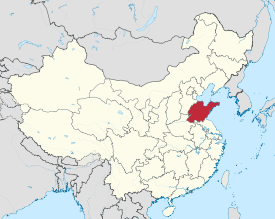Shandong
|
Shandong Province 山东省 |
|
|---|---|
| Province | |
| Name transcription(s) | |
| • Chinese | 山东省 (Shāndōng Shěng) |
| • Abbreviation | /魯 (pinyin: Lǔ) |
 Map showing the location of Shandong Province |
|
| Coordinates: 36°24′N 118°24′E / 36.4°N 118.4°ECoordinates: 36°24′N 118°24′E / 36.4°N 118.4°E | |
| Capital | Jinan |
| Largest city | Linyi |
| Divisions | 17 prefectures, 140 counties, 1941 townships |
| Government | |
| • Secretary | Jiang Yikang |
| • Governor | Guo Shuqing |
| Area | |
| • Total | 157,100 km2 (60,700 sq mi) |
| Area rank | 20th |
| Population (2014) | |
| • Total | 97,333,900 |
| • Rank | 2nd |
| • Density | 620/km2 (1,600/sq mi) |
| • Density rank | 5th |
| Demographics | |
| • Ethnic composition |
Han - 99.3% Hui - 0.6% |
| • Languages and dialects | Jiaoliao Mandarin, Jilu Mandarin, Zhongyuan Mandarin |
| ISO 3166 code | CN-37 |
| GDP (2016) |
CNY 6.7trillion US$1.01billion (3rd) |
| • per capita |
CNY ¥ 69,953 US$ 10,534 (9th) |
| HDI (2010) | 0.721 (high) (9th) |
| Website | www |
| Shandong | |||||||||||||||||||||||||||||||

"Shandong" in Simplified (top) and Traditional (bottom) Chinese characters
|
|||||||||||||||||||||||||||||||
| Simplified Chinese | 山东 | ||||||||||||||||||||||||||||||
|---|---|---|---|---|---|---|---|---|---|---|---|---|---|---|---|---|---|---|---|---|---|---|---|---|---|---|---|---|---|---|---|
| Traditional Chinese | 山東 | ||||||||||||||||||||||||||||||
| Postal | Shantung | ||||||||||||||||||||||||||||||
| Literal meaning | "East of the Tàiháng Mountains" | ||||||||||||||||||||||||||||||
|
|||||||||||||||||||||||||||||||
| Transcriptions | |
|---|---|
| Standard Mandarin | |
| Hanyu Pinyin | Shāndōng |
| Bopomofo | ㄕㄢ ㄉㄨㄥ |
| Gwoyeu Romatzyh | Shandong |
| Wade–Giles | Shan1-tung1 |
| IPA | [ʂán tʊ́ŋ] |
| Wu | |
| Romanization | Se平 ton平 |
| Yue: Cantonese | |
| Yale Romanization | Sāan-dūng |
| Jyutping | Saan1-dung1 |
| Southern Min | |
| Hokkien POJ | Soaⁿ-tang |
| Tâi-lô | Suann-tang |
Shandong (Chinese: 山东; formerly romanized as Shantung) is a coastal province of the People's Republic of China, and is part of the East China region.
Shandong has played a major role in Chinese history from the beginning of Chinese civilization along the lower reaches of the Yellow River and served as a pivotal cultural and religious site for Taoism, Chinese Buddhism, and Confucianism. Shandong's Mount Tai is the most revered mountain of Taoism and one of the world's sites with the longest history of continuous religious worship. The Buddhist temples in the mountains to the south of the provincial capital of Jinan were once among the foremost Buddhist sites in China. The city of Qufu is the birthplace of Confucius, and was later established as the center of Confucianism.
Shandong's location at the intersection of ancient as well as modern north–south and east–west trading routes have helped to establish it as an economic center. After a period of political instability and economic hardship that began in the late 19th century, Shandong has emerged as one of the most populous (95,793,065 inhabitants at the 2010 Census) and most affluent provinces in the People's Republic of China with a GDP of CNY¥5.942 trillion in 2014, or USD$967 billion, making it China's third wealthiest province.
Individually, the two Chinese characters in the name "Shandong" mean "mountain" (山) and "east" (东). Shandong could hence be translated literally as "east of the mountains" and refers to the province's location to the east of the Taihang Mountains. A common nickname for Shandong is Qílǔ (simplified Chinese: ; traditional Chinese: ), after the States of Qi and Lu that existed in the area during the Spring and Autumn period. Whereas the State of Qi was a major power of its era, the State of Lu played only a minor role in the politics of its time. Lu, however, became renowned for being the home of Confucius and hence its cultural influence came to eclipse that of the State of Qi. The cultural dominance of the State of Lu heritage is reflected in the official abbreviation for Shandong which is "鲁" (Chinese: ; pinyin: Lǔ). English speakers in the 19th century called the province Shan-tung.
...
Wikipedia
